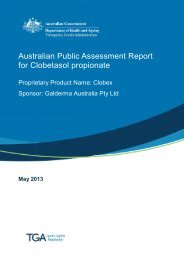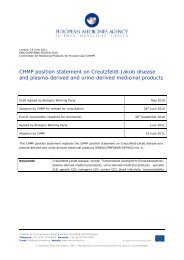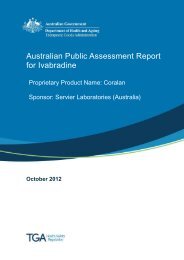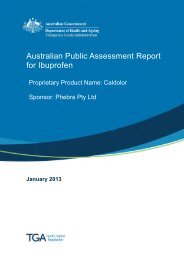AusPAR: Cabazitaxel - Therapeutic Goods Administration
AusPAR: Cabazitaxel - Therapeutic Goods Administration
AusPAR: Cabazitaxel - Therapeutic Goods Administration
You also want an ePaper? Increase the reach of your titles
YUMPU automatically turns print PDFs into web optimized ePapers that Google loves.
<strong>AusPAR</strong> Jevtana <strong>Cabazitaxel</strong> Sanofi-Aventis Australia Pty Ltd PM-2010-02565-3-4<br />
Final 9 February 2012<br />
<strong>Therapeutic</strong> <strong>Goods</strong> <strong>Administration</strong><br />
cabazitaxel had no significant effects on hERG current (hERG channel expressed in CHO<br />
cells) or on action potential parameters in isolated sheep Purkinje fibres.<br />
<strong>Cabazitaxel</strong> pharmacokinetics following IV administration were characterised by rapid<br />
clearance and a large volume of distribution in all species (mice, rats, dogs and humans),<br />
although half life was longer in humans than in the laboratory animal species. <strong>Cabazitaxel</strong><br />
and/or its metabolites were widely distributed in rats, with high concentrations in highly<br />
perfused tissues, the gastrointestinal tract (consistent with biliary excretion) and<br />
glandular tissues/organs. Radioactivity was more slowly eliminated from the brain than<br />
from blood or other organs. Distribution of radioactivity within the brain was<br />
heterogeneous, with highest concentrations in the ventricular system. There was no<br />
evidence in pigmented rats of an affinity of drug/metabolites for melanin. In vitro protein<br />
binding was high (>85%) in all species. <strong>Cabazitaxel</strong>/metabolites crossed the placenta in<br />
pregnant rats and small amounts were excreted into milk in lactating rats.<br />
The major metabolic pathways for cabazitaxel were O-demethylations and a t-butyl<br />
hydroxylation on the lateral chain, followed by cyclisation leading to oxazolidine or<br />
oxazolidinone type compounds. These pathways were found in all species (mice, rats, dogs<br />
and humans). In all tested species, although cabazitaxel was extensively metabolised with<br />
little excreted as parent drug, cabazitaxel was the main circulating compound. Metabolism<br />
of cabazitaxel was shown to be largely catalysed by CYP3A4 and CYP3A5 and to a lesser<br />
extent by CYP2C8. Excretion was largely biliary (10, whereas in rats and dogs, they were generally
















